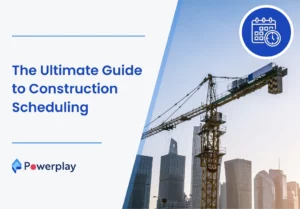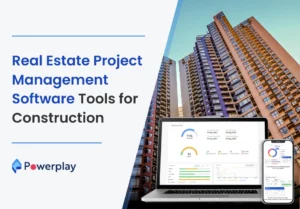What are Construction Submittals?
-
Sapna
- April 23, 2024

Construction submittals are essential documents, plans, or samples contractors submit to ensure that project work complies with the design specifications before commencement. They play a critical role in managing and documenting the flow of project materials, ensuring quality control, and facilitating communication among all project stakeholders.

In this blog will learn about ins and outs of construction submittals, from their definition to the detail process of managing them effectively and understand about why these components are required in ensuring the successful execution of construction projects.
Table of Contents
ToggleWhat is a Submittal?
In construction management, a submittal refers to documents, samples, or proposals submitted by a contractor to the architect, engineer, or client for approval. These documents typically include drawings, material data, schedules, and product literature, which must be reviewed and approved before work starts. This process ensures that the materials and methods proposed by the contractor meet the project specifications and standards.
In essence, submittals are vital for ensuring the highest quality in a construction project. They ensure all materials and workmanship adhere to the design requirements and regulatory compliances. They facilitate communication among the contractor, architect, and client, providing a documented trail of decision-making and approvals. This helps manage quality control, minimise errors, and ensure the project unfolds as planned.
What is the Purpose of Submittals?
The purpose of submittals in construction projects is multifaceted and critical for ensuring the quality and compliance of the building process.
The main key objectives of sharing Submittals in construction management are:

- Verification and Compliance: Submittals’ main purpose is to verify that the materials, products, and equipment proposed by the contractor meet the specified requirements outlined in the project documents. They also ensure compliance with industry standards, building codes, and specific project criteria, which is essential for the safety and functionality of the structure.
- Quality Control: By reviewing submittals, project managers, architects, and engineers can check the quality of materials and components before they are purchased and installed. This step is crucial to prevent substandard materials that could affect the durability and performance of the final construction.
- Coordination and Clarity: Submittals help maintain clear communication and coordination among various stakeholders, including contractors, subcontractors, designers, and clients. They provide a documented process that clarifies and records decisions related to materials and design details, thereby minimising misunderstandings and errors during construction.
- Record Keeping and Documentation: Submittals serve as a formal record of what is to be installed in the project, providing a trail of documentation that can be referred to in case of disputes or future renovations or maintenance. This documentation is crucial for maintaining a clear historical account of the decision-making process and materials selection.
- Facilitate Approval Processes: The submittal process allows architects and engineers to approve or make necessary adjustments to proposals before actual work begins. This proactive review and approval can prevent costly modifications and delays that might arise if issues are only identified after materials are fabricated or installed.
RFIs in the Submittal Process
Requests for Information (RFIs) play a crucial role in construction projects during the submittal process. RFIs are formal inquiries made by contractors to the design team seeking clarifications on unclear project drawings or specifications.
These inquiries are essential for contractors to ensure their submittals, which include proposals, samples, and drawings meant for approval, accurately reflect the project requirements. The submittal process is tightly linked with RFIs because questions often arise when preparing documents or choosing materials that require confirmation from architects or engineers. Ideally, all RFIs would be resolved before submittals are finalised to avoid misinterpretations that could lead to costly errors or delays.
However, in practical scenarios, the process of creating submittals can discover further ambiguities, causing an interplay between generating RFIs and submittals as the project team collaboratively addresses and resolves issues related to the feasibility and execution of the design. This iterative process ensures precision and compliance throughout the project development.
Common Types of Submittals
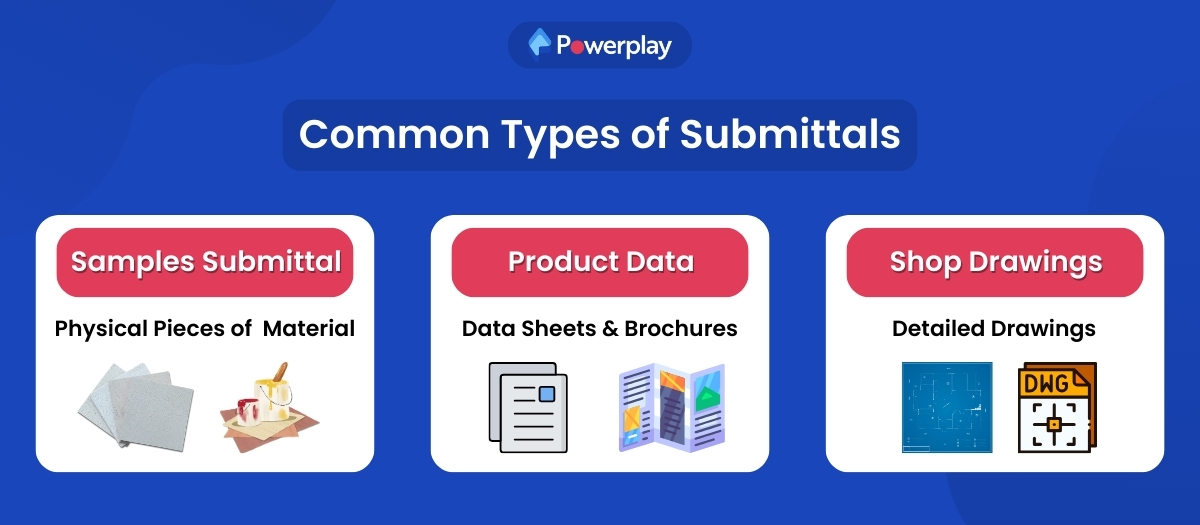
Submittals are crucial in construction projects to ensure that all components meet the specified requirements before installation. Some of the most common submittals used in construction are samples, product data, and shop drawings. Let’s learn these in detail in the following.
Samples:
Samples submittals are physical pieces of the material or items used in the construction. The contractor shares them for approval to confirm that the characteristics and aesthetics match the project specifications.
Samples could include fabric, roofing tiles, or paint chips. The purpose of sharing the samples is to ensure that the visual and tactile qualities of materials meet the design intent and are suitable for their application. This process will help prevent costly changes after bulk materials have been purchased or installed.
Product Data:
Product Data submittals consist of pre-manufactured components’ data sheets, brochures, or literature provided by the manufacturers. These documents provide detailed information about the product’s performance characteristics, dimensions, installation procedures, colour options, and maintenance guidelines.
Product data is reviewed to verify that the products proposed by the contractor stick to the technical specifications required for the project and are compatible with other components.
Shop Drawings:
Shop Drawings are detailed drawings prepared by the contractor, supplier, or manufacturer, showing how specific elements of the project will be fabricated and installed. Unlike architectural drawings, shop drawings typically include more detail and are specific to the manufacturing processes involved.
They may show the layout, dimensions, fabrication, assembly, and installation details for steel framing, custom cabinetry, or intricate millwork. Shop drawings ensure that the fabricator or installer and the design team fully agree on how the project’s detailed elements will be executed.
Information to Include in a Submittal
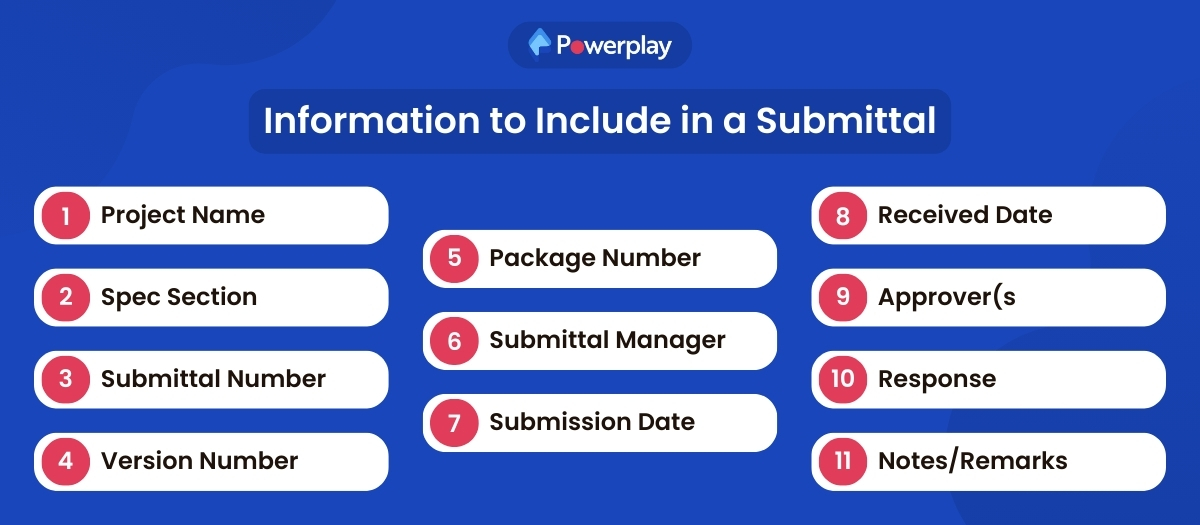
When assembling a submittal package for a construction project, it’s important to include specific information that facilitates clear communication and efficient tracking of the documents through the approval process.
Here is the essential information to include in a submittal:
Project Name:
The project name must be included as it identifies the construction project for which the submittal is prepared. It helps organise and reference the correct project in communications and documentation.
Spec Section:
This refers to the specific section of the project specifications that the submittal addresses. This ensures that the materials or methods proposed in the submittal are reviewed in the context of the relevant requirements.
Submittal Number:
Ensure that each submittal has a unique identifier assigned for tracking and referencing purposes. This number helps organise the review process and ensure all submittals are accounted for and traceable.
Revision or Version Number:
It Indicates the loop of the submittal document. As submittals can go back and forth in the review process, tracking the revision number ensures that the most current version is being used and reviewed.
Package Number:
Sometimes, submittals are grouped into packages, especially when related documents or materials need to be reviewed together. Adding the package number helps manage these groups effectively.
Submittal Manager:
The person responsible for preparing and managing the submittal process. This could be a project engineer, a document controller, or another designated team member. Having a named individual simplifies communication and accountability.
Submission Date:
The date the submittal was sent to the reviewing party. This date is important for tracking the review timeline and ensuring timely responses.
Received Date:
The date the submittal was acknowledged as received by the reviewer or the approval authority. This helps monitor the review process’s time and ensure adherence to project schedules.
Approver(s):
The name of the person or team responsible for reviewing and approving the submittal. Knowing who the approvers are can facilitate direct communication and expedite necessary discussions.
Response:
The official response to the submittal is typically marked as approved, approved as noted, or rejected. This entry is crucial as it directly affects the progress of the project based on the acceptance or required modifications of the proposed materials or methods.
Notes/Remarks:
Additional comments provided by the reviewers will help clarify decisions, guide revisions, or detail reasons for rejection. Notes and remarks can provide actionable feedback to the submitting party for necessary adjustments or confirmations.
The Construction Submittal Process:
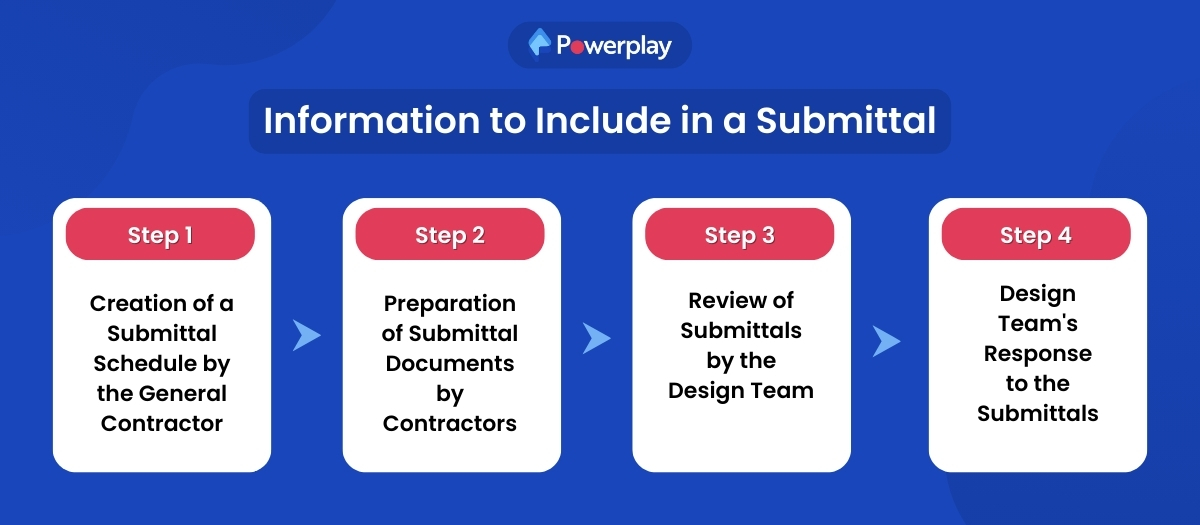
The construction submittal process is a critical component of project management. It ensures that all materials and methods meet predefined specifications and design requirements. It involves submitting, reviewing, and approving documents such as drawings, material data, and samples, facilitating communication and quality assurance between contractors and the design team.
Step 1: Creation of a Submittal Schedule by the General Contractor
At the outset, the general contractor develops a submittal schedule, which outlines the timeline for when various submittals must be prepared, submitted, and reviewed. This schedule is aligned with the project timeline to ensure that material procurement and project milestones proceed without delays. It serves as a roadmap for all parties involved in the construction project about when and what documents need to be reviewed.
Step 2: Preparation of Submittal Documents by Contractors
Contractors, including subcontractors and suppliers, prepare the necessary submittal documents according to the submittal schedule. These documents can include detailed drawings, material samples, product data, and other relevant information that needs approval from the design team. The accuracy of these documents is vital as they ensure that the proposed materials and methods comply with the project specifications.
Step 3:Review of Submittals by the Design Team
Once the submittal documents are submitted, the design team, which typically includes architects and engineers, reviews them to ensure compliance with the project’s design and specifications. This step is vital for quality control and verifying that the materials and workmanship meet the required standards and codes. The review process may involve checking for discrepancies, ensuring compatibility with other project elements, and validating product performances.
Step 4: Design Team’s Response to the Submittals
After a thorough review, the design team responds to each submittal. The response can be an approval, a revision request, or a rejection based on how well the submittal meets the project requirements. This feedback is communicated back to the contractor, who must act on it, either proceeding with the procurement and installation of approved materials or making the necessary adjustments to the submittals that require revisions or were rejected.
Process Roles & Responsibilities
In the construction submittal process, each participant has different roles and responsibilities that contribute to the project’s success. Many participants share a submittal. Here’s an overview of the roles involved and their specific responsibilities:
The Project Owner:
- Oversight and Direction: The project owner provides the overall vision, requirements, and expectations. They approve the project scope and budget and ensure that the submittals align with their objectives and standards.
- Decision-Making: The owner has the ultimate decision-making authority, especially in accepting the recommendations and approvals given by the design team and other consultants.
The Design Team:
- Review and Approval: The design team, which includes architects, engineers, and sometimes specialised consultants, is responsible for reviewing submittals to ensure they meet all project specifications, design requirements, and regulatory compliance.
- Technical Guidance: They provide clarifications and responses to RFIs, helping to resolve issues raised during the submittal review process.
Construction Manager or Owner’s Rep:
- Coordination and Communication: Acts as the involvement between the project owner and the construction teams. They ensure that the submittal process adheres to the project timelines and that communications are clear and documented.
- Monitoring Compliance: They oversee the construction activities to ensure compliance with the project specifications and manage the submittal log to track all documents throughout the project lifecycle.
General Contractor:
- Management of Submittals: The general contractor is responsible for compiling and submitting all necessary submittal documents from subcontractors and suppliers. They ensure these documents are complete and conform to the requirements before sending them to the design team for approval.
- Scheduling: They develop and maintain the submittal schedule, coordinating the timing of submittals based on project needs and construction sequencing.
Subcontractor:
- Preparation of Detailed Information: Subcontractors generate detailed submittals, including shop drawings, product data, and samples, specific to their scope of work.
- Technical Specifications: They ensure that their submittals accurately reflect the technical specifications, quality of materials, and workmanship required by the project.
Suppliers and Fabricators:
- Provision of Product Data and Samples: Suppliers and fabricators provide the documentation and physical samples for products and materials to be used in the project, as required for submittal approval.
- Conformance to Standards: They ensure that all items supplied meet the project’s specifications and applicable standards or regulations.
What is the difference between an RFI and a submittal?
Key differences between an RFI (Request for Information) and a submittal in construction management:
| Aspect | RFI (Request for Information) | Submittal |
| Purpose | To clarify ambiguities, gather information, and resolve uncertainties in project documents. | To provide detailed documentation, samples, or information required for approval before proceeding with certain aspects of the construction. |
| Initiation | Initiated by contractors or subcontractors when clarification or additional information is needed. | Prepared and submitted by contractors or subcontractors as required by contract specifications. |
| Content | Questions or requests for clarification regarding plans, specifications, or contracts. | Detailed plans, drawings, specifications, material data, and samples related to the construction project. |
| Outcome | Responses to RFIs may lead to changes in work scope, methods, or understanding of project details. | Approval, revision, or rejection of materials or methods proposed, ensuring compliance with project specifications. |
| Frequency of Use | Used throughout the project as new questions and issues arise. | Typically used at specific stages of the project, especially before major phases of construction begin. |
| Impact on Project | Aims to prevent miscommunication and potential project delays by ensuring all parties have the same information. | Ensures that all materials and methods used in the project meet the agreed-upon standards and specifications, directly impacting the quality and compliance of the construction. |
.
Key Factors That Affect Submittals
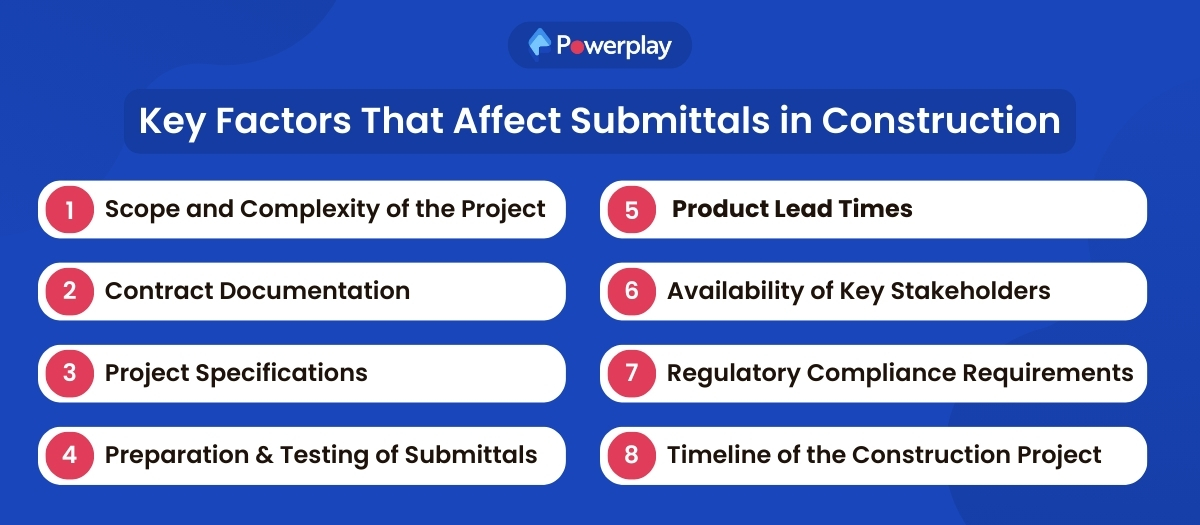
Key factors that affect the submittals in construction projects are:
Scope and Complexity of the Project:
The broader and more complex the project, the more detailed and numerous the submittals tend to be. Larger projects often require more comprehensive documentation to ensure all aspects meet the specified standards and functionalities.
Contract Documentation:
The contract documents define the standards, procedures, and requirements for submittals. They include all necessary details that guide the preparation, submission, and review processes, directly impacting how submittals are handled.
Project Specifications:
Detailed project specifications dictate the types of materials and methods to be used. These specifications must be adhered to in the submittals, as they outline the technical and performance criteria that materials and construction techniques must meet.
Preparation and Testing of Submittals:
The accuracy of submittal preparation and the extent of testing required (e.g., for material strength or durability) can significantly influence review and approval times, impacting project timelines.
Product Lead Times:
The lead times for procuring materials or equipment can affect the submittal process, especially if long lead items need early approval to avoid delays in the project schedule.
Availability of Key Stakeholders:
The availability of project stakeholders, such as designers, contractors, and client representatives, to review and approve submittals can influence the pace of the process, potentially impacting project deadlines.
Regulatory Compliance Requirements:
Adherence to local, state, and federal regulations affects submittals, as all materials and construction practices must comply with relevant safety and environmental standards.
Timeline of the Construction Project:
The overall construction schedule plays a critical role, as the timing of submittal approvals needs to be synchronised with project phases to prevent delays in the commencement or completion of construction activities.
Solving Common Submittal Challenges
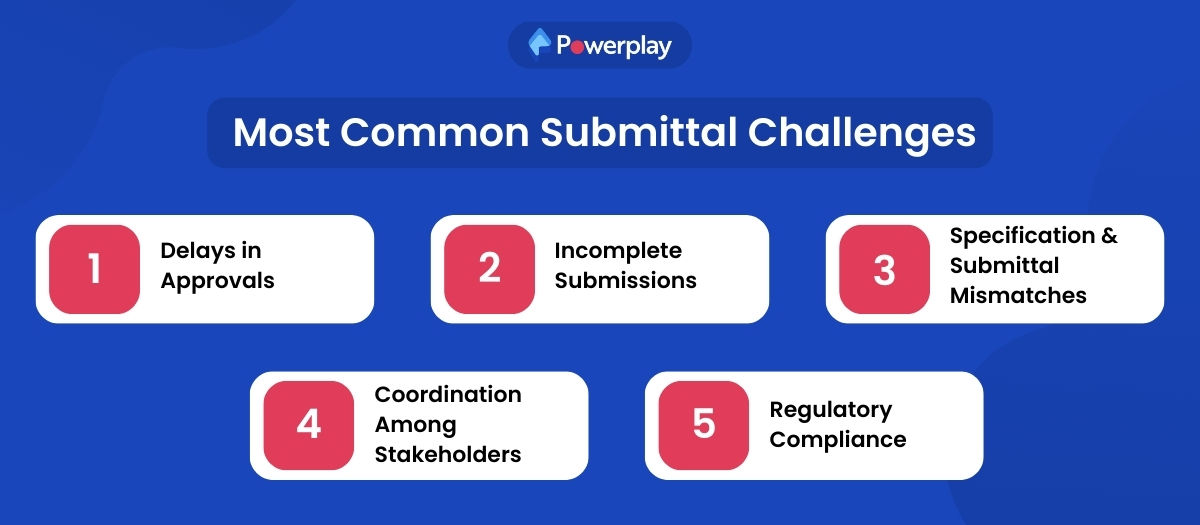
Managing submittals in construction projects can be complex and can include several common challenges that may arise. The most common challenges which are:
- Delays in Approvals: One of the most frequent issues is delays in the approval process. These delays can happen due to various factors, including slow response times from the reviewing team or backlogs in processing submittals.
- Incomplete Submissions: Often, submittals may be returned if they contain inaccurate or incomplete information. Ensuring all details are correct and fully documented is crucial to avoid such setbacks.
- Specification and Submittal Mismatches: Discrepancies between the project specifications and the submittals can lead to rejections or requests for revisions. Aligning the submittals with the specified requirementsusually requires additional work.
- Coordination Among Stakeholders: Communication and coordination among various stakeholders, such as architects, engineers, and contractors, are essential. Misalignment or miscommunication can lead to errors in submittals, impacting project timelines and costs.
- Regulatory Compliance: Submittals must also comply with all relevant regulations and standards. Failing to achieve these requirements can lead to non-approval and potential legal and safety issues down the line.
How Can You Improve Your Submittal Process?
Improving your submittal process involves several key strategies:
- Implement a digital management system to track and organise submittals efficiently, ensuring all documents are accessible and up-to-date.
- Establish clear guidelines and checklists for preparing submittals to reduce errors and omissions.
- Foster strong communication between all project stakeholders, including contractors, architects, and engineers, to ensure quick resolution of any issues.
- Schedule reviews to assess the effectiveness of the submittal process and make necessary adjustments. These steps will streamline the process, reduce delays, and enhance project management efficiency.
Improving the submittal process in construction projects is crucial for enhancing efficiency, reducing delays, and ensuring quality compliance. By following all these necessary guidelines, you can execute construction owners’ projects more efficiently and seamlessly.
